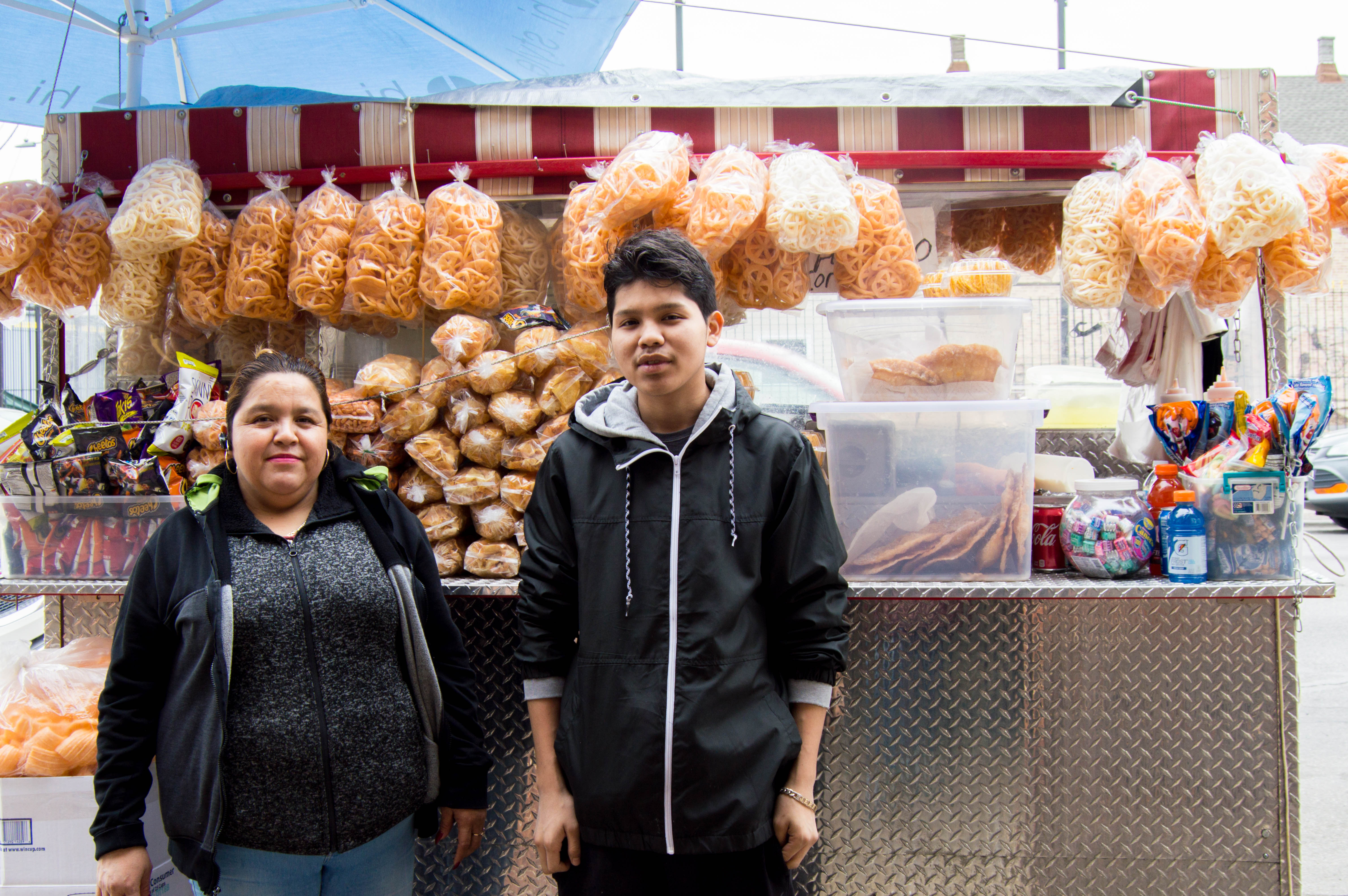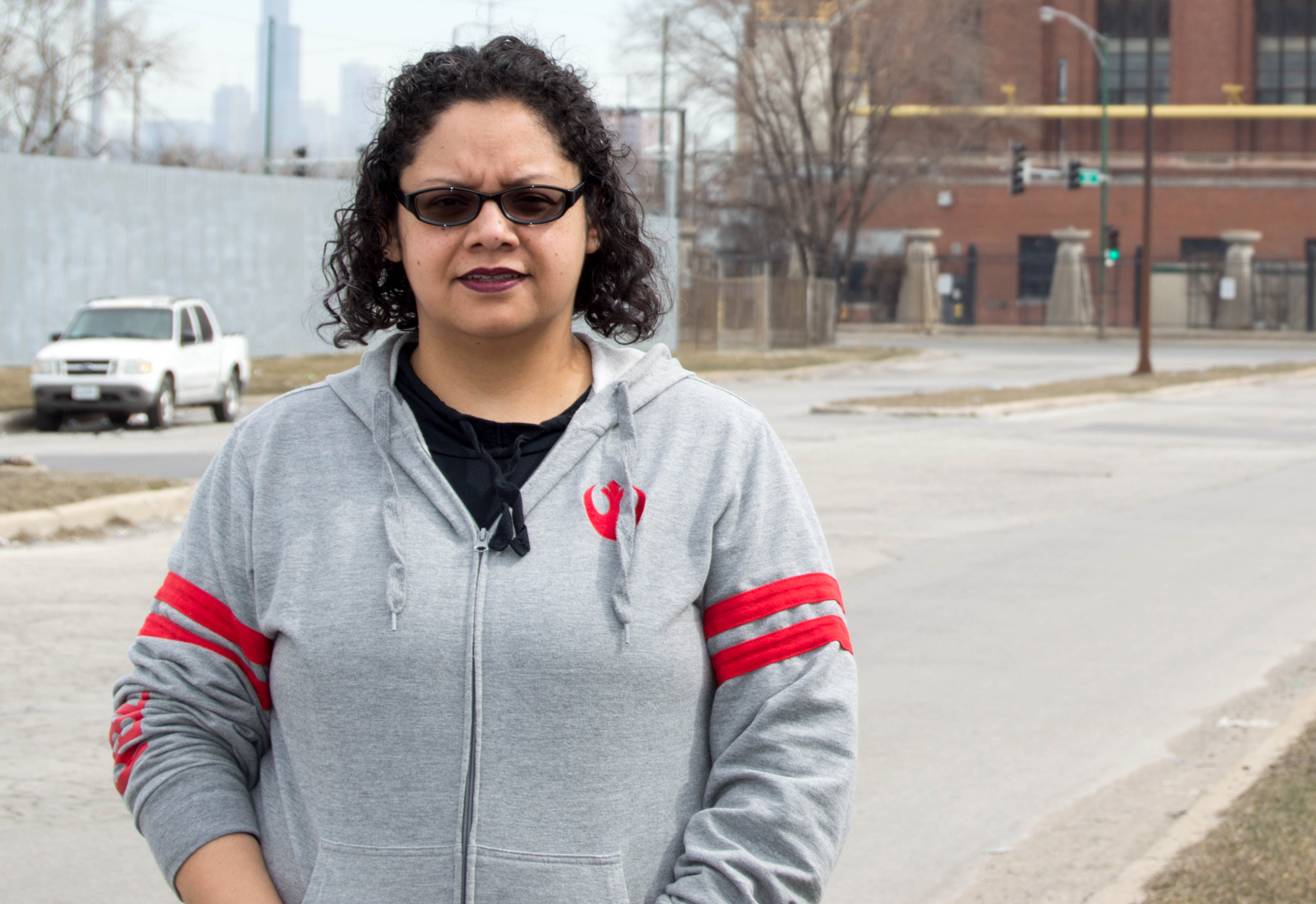
(Photo: Sophie Yeo)
Jerry Rodriguez helps his mother, Sonia Ruiz, set up her food cart in Little Village, Chicago, every day before school. The stall sells the usual Mexican fare—tamales, corn, champurrado—alongside sacks full of chips.
Their stall is located on 26th Street, reportedly the highest-grossing shopping district in Chicago after the city’s fashionable Magnificent Mile. As well as the rolling food carts, the two-mile stretch is cluttered with shops selling piñatas, cheap shoes, and voluminous quinceañera dresses. It branches into residential streets dabbed with colorful murals.
But it’s the food carts and the 166 restaurants dotting Little Village that give the area its vibrancy. Many of the immigrants in Little Village brought over agricultural skills from Mexico, where they once worked on farms or grew fresh vegetables. Astoundingly, 100 percent of Chicago’s food vendors are Hispanic, according to a survey undertaken by the Illinois Policy Institute in 2015, and they operate primarily in Little Village.
Despite their importance to the character and economy of the neighborhood, these vendors face some of the most burdensome regulations in the country, while they compete over space for growing and storing fresh produce. On top of these challenges, the neighborhood sits alongside one of the city’s 24 industrial corridors, a gray expanse that includes a Hellmann’s mayonnaise factory, a garbage sorting facility, and a former coal plant—the Crawford Generating Station.
This coal plant is at the center of a brewing battle in Little Village. For more than a decade, environmental groups fought to shut down the plant, with good reason: According to a 2002 study by the Harvard T.H. Chan School of Public Health, air pollution from the Crawford coal plant was responsible for 26 deaths, 1,800 asthma attacks, and 350 emergency room visits every year.

(Photo: Wikimedia Commons)
Yet its closure could turn out to be a Pyrrhic victory for environmentalists. The site was recently purchased by Hilco Redevelopment Partners, which hopes to demolish the plant and turn the plot into a “last-mile” distribution and logistics facility for the city of Chicago, enabling trucks and vans to take products to their final destinations. While the company has promised jobs and development, Kim Wasserman, executive director of Little Village Environmental Justice Organization, fears that the project will lead to more diesel trucks, air pollution, exploitation, and gentrification, alongside a potentially toxic demolition process.
Wasserman explains all this while driving me toward the industrial complex in Little Village one day in March. She played a key role in the Crawford plant’s closure in 2012. “This is my pride and joy,” Wasserman says, as she swings her car around the corner and we are confronted with 72 acres of brickwork and smokestacks.
This coal plant is surrounded by an incongruously pleasant landscaping effort—an unintended side effect of Wasserman’s dogged campaigning. Perturbed by the buses of tourists whom Wasserman would cart around on “Toxic Tours” of the neighborhood, the company planted these trees in a literal attempt to make the plant look greener, she says.
Facilities such as the Hellmann’s mayonnaise factory, which sits adjacent to an elementary school, mean the community is already familiar with the sight of large diesel-powered trucks on their streets. These release ultra-fine particles, which pollute the air and cause various health problems. Wasserman estimates that a new logistics facility could quadruple the number of trucks on the road in Little Village.
“This is not a small issue,” says Henry Henderson, director of the Midwest program at the Natural Resources Defense Council. He points out that transportation and logistics have already caused severe pollution problems in areas like the Port of Los Angeles, where Californians pay up to $590 million annually in health costs related to truck pollution.
Rather than building a distribution facility, Wasserman wants the site to be used for the benefit of Little Village’s many street vendors and food producers—essentially a massive expansion of the small community garden she helped to establish around 10 years ago. There, local families grow vegetables, gather for potlucks, and learn about sustainability and climate adaptation. The day before I met Wasserman, gardeners had gotten together to reinforce their fences after raccoons raided the chicken coop, a party that culminated in the offsite slaughter of another two chickens for soup.*

(Photo: Sophie Yeo)
But while one and a half acres and a well-stocked chicken coop may provide amply for raccoons, Wasserman has bigger plans for the Crawford coal plant. She envisions a scenario where a certain number of square feet are donated, or bought, by the neighborhood and used for urban indoor farms, commercial kitchen space, composting facilities, and vendor cart storage space.
“It would be beneficial if there was a place to plant my own fruit and vegetables to use for the stand,” vendor Sonia Ruiz says in Spanish. Ruiz currently stores her ingredients in four fridges and two freezers she keeps in her home.
As well as providing much-needed space, such facilities could help vendors to abide by the city’s strict sanitation regulations.
“It became very clear that space—land—is what’s needed. We’re trying to understand the many complexities of what it means for a person of color in Illinois to try to access farmland. And let me tell you, it is not an easy process in any sense of the word,” Wasserman says. “Chicago, to a certain extent, is safe for a person of color, but once you leave those borders it’s not so safe. I go to Indiana, and I see gas stations with Ku Klux Klan flags on them. So that means we have to find land in our own neighborhood. But the only land available is the land in the industrial corridor, so what options does that leave us?”
While the health and climate effects of air pollution and diesel emissions are central motivations in this fight, it is also about ensuring that the transition of the coal plant into something else benefits the community financially. While Wasserman wants her community to be free of coal, she also wants to ensure that the jobs that replace it offer fair pay and don’t push out the neighborhood’s Hispanic residents, many of whom are undocumented and speak little English.

(Photo: Sophie Yeo)
The dilemma is one that is increasingly facing environmental organizations and labor unions, particularly during campaigns to close coal plants: How do you ensure that workers aren’t left in poverty after the industry has left the area? And how do you ensure that any new jobs will treat workers fairly?
The challenge is commonly referred to as securing a “just transition.” The concept is so important that it even made it into the United Nations’ 2015 Paris Agreement, which takes into account the “imperatives of a just transition of the workforce and the creation of decent work and quality jobs.”
One prominent example of putting this concept into action came in 2016, with a joint proposal issued by utility company PG&E and various environmental groups concerning the orderly phase-out of a nuclear power plant, Diablo Canyon, in California.
This proposal included a commitment to replace the power-generating capacity of the plant with a “GHG [greenhouse gas]-free portfolio of energy efficiency, renewables and energy storage,” alongside a commitment to retain the current workforce until the plant’s retirement. The California Public Utilities Commission recently rejected a number of these provisions, arguing, for instance, that PG&E would likely “fail” to achieve its clean energy goal—another indication of the difficulties that accompany the fight for a just transition nationwide.
For many in Little Village, the battle is simply for an acceptable quality of life, where they can breathe freely and be valued for the skills that they brought with them from their native country.
“Our master gardener is a construction worker. He builds Victoria’s Secrets, he builds storage, he puts up brick. But before he came here, he was a garlic grower,” Wasserman says. “What he wants more than anything is to have a job that reconnects him with the earth. He would be the happiest if could spend his days walking among rows and rows of garlic.”
New Landscapes is a regular series investigating how environmental policies are affecting communities across America.
*Update—April 9th, 2018: This article has been updated to reflect that it was raccoons, not coyotes, that raided the chicken coop.




